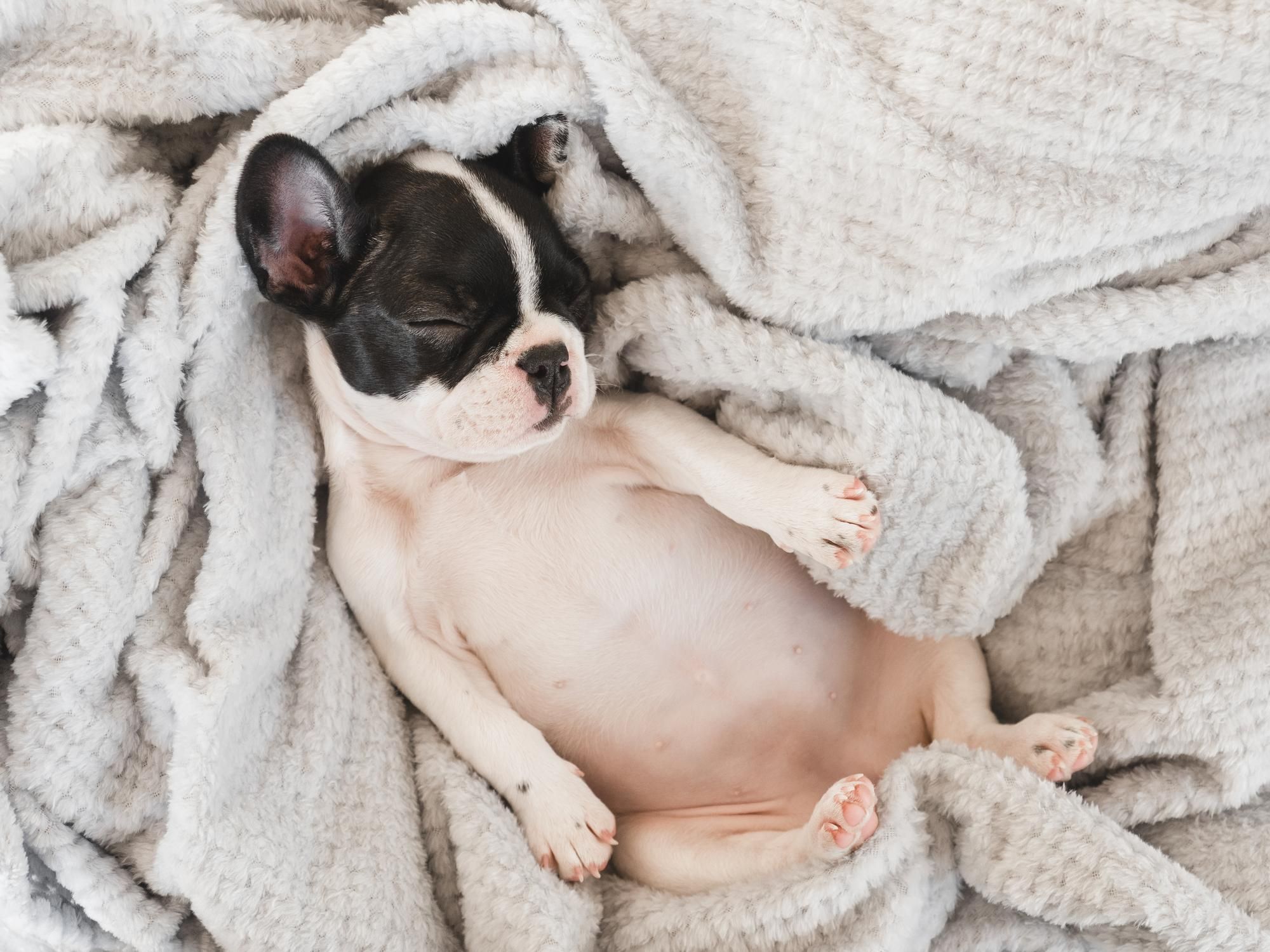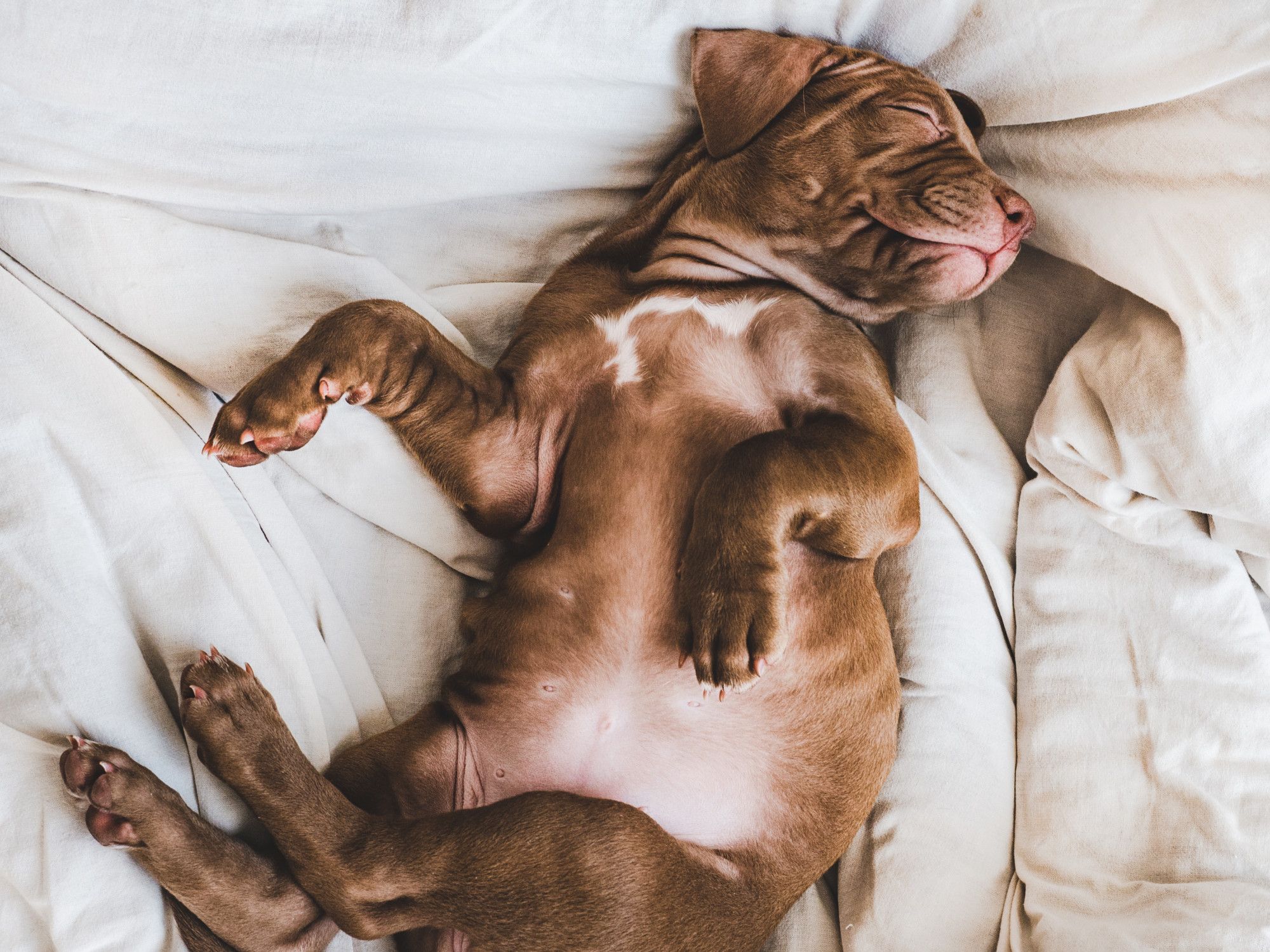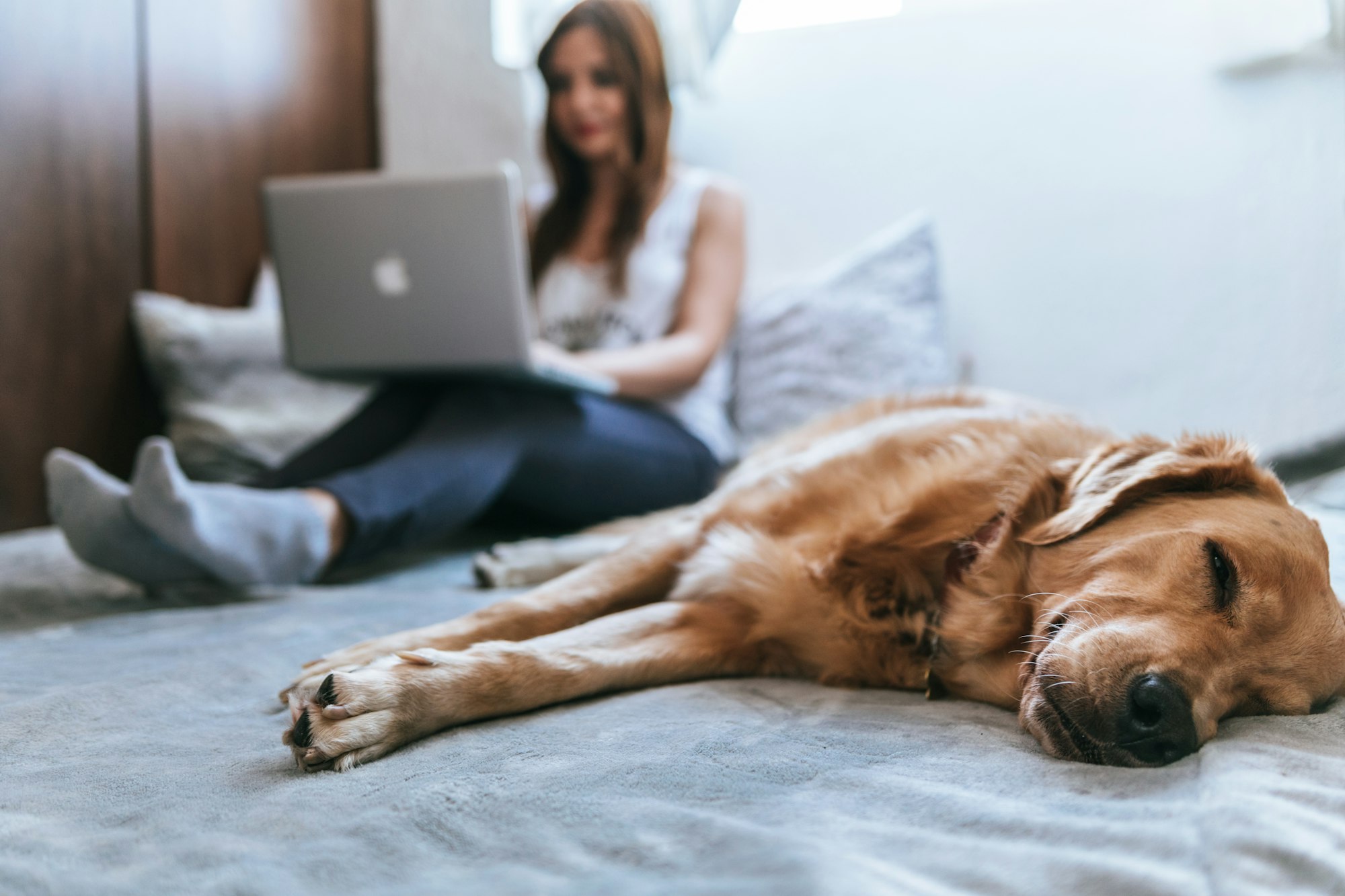The sleeping position of a puppy can reveal a lot about its comfort level, health, and overall well-being. One such position that often catches the eye is when a puppy sleeps on its back with all four paws up in the air.
While it may look adorable, it is essential to understand what this position might mean for your furry friend's physical and emotional state. This article will explore the secret language behind your puppy's sleeping position when they lay on their back with their paws up.
We will explore the potential reasons why puppies might adopt this position and what it could indicate about their comfort level, temperature regulation, and overall health. Additionally, we will discuss how you can encourage good sleep habits for your puppy and identify signs that may require a visit to the vet.
Understanding your puppy's sleeping posture better can deepen your bond with them while ensuring their optimal health and well-being.
What does it mean When Puppy Sleeps on Back?

The position in which a puppy sleeps can provide insight into various aspects of its physical state and overall well-being. If you've ever noticed your dog sleeping on its back, with paws up in the air, it often indicates a high level of comfort and security in its surroundings.
This is one common dog sleeping position where they can fully relax their muscles and release any tension or stress accumulated throughout the day. Dogs lie on their backs to regulate body temperature, especially during warmer months when overheating can be a serious risk. This position exposes the belly to the cooler air, helping the puppy to keep cool and avoid overheat.
Another benefit of this position for dogs is that it allows better blood and oxygen circulation throughout the body. If you notice your dog sleeps in this position frequently, it likely indicates that they are feeling content and well-rested. This sleep position means that your dog trusts you and your environment.
However, dogs also have other sleeping positions like sleeping on their side, which can indicate deep sleep. Just as humans have sleep patterns, dogs' sleep patterns may vary.
Some dogs may sleep on their side or stomach, while others love to sleep on their backs. If you notice changes in your dog's sleeping habits, like an aversion to falling asleep in a previously favored position, it could signify a health issue, so it's a good idea to consult with a veterinarian.
Despite their different sleep habits, never wake your dog abruptly when it's in a deep sleep, even if your dog sleeps on his back with their legs in the air. They could be startled, and this could disrupt their snooze time. Remember, sleep is essential for a puppy's growth and development, and it's our responsibility as pet owners to help our dogs achieve healthy sleep habits.
Observing your dog's sleep positions and the position they fall asleep in can provide valuable insights into their health and happiness. This is especially important if you're introducing another dog into the home, as understanding sleep cues can help your dog's transition go more smoothly.
Can Dogs Breathe When They Sleep On Their Backs?

Do dogs face any respiratory challenges while the dog is sleeping on their backs? The answer is no. Dogs are able to breathe comfortably in any position, including when they sleep on their backs.
This may seem surprising since it is a vulnerable position for them to be in, but dogs have evolved to be able to adapt and feel comfortable in many different positions.
When a pup sleeps on its back, it could mean they feel comfortable and relaxed. It is also possible that the dog may be trying to cool down as exposing their belly helps regulate body temperature.

Additionally, sleeping on his back allows your dog to air out paw pads which can get sweaty or moist during daily activities. As long as your dog appears healthy and happy while sleeping on his back, there should be no concern over their breathing ability or overall well-being.
Can Flat-Faced Dogs Sleep on Their Backs?

Flat-faced dog breeds, such as bulldogs and pugs, may experience difficulties sleeping on their backs due to their unique respiratory anatomy. These dogs have shorter snouts and narrower airways, making it harder for them to breathe when lying flat on their backs. As a result, they may be more comfortable sleeping in other positions that allow for easier breathing.
However, it is important to note that not all flat-faced dogs will have difficulty sleeping on their backs. Some may still prefer this position and can do so without any issues. Additionally, older dogs or those with respiratory problems may also struggle with back sleeping regardless of breed.
Ultimately, a dog's sleep position means different things for different breeds and individuals. It is important to observe your pet's behavior and preferences regarding sleep positions and provide them with a comfortable dog bed that accommodates their needs.
Furthermore, remember that dogs sweat through their paw pads rather than skin pores as humans do; therefore, having paws in the air while sleeping does not necessarily mean they are hot or uncomfortable but could be a preferred position for relaxation.
Short History of Dogs Sleeping on Their Backs
Throughout history, dogs have been observed sleeping in various positions, including on their backs with extended legs. This position isn't exclusive to puppies; adult dogs sleep in this manner too. However, it is more commonly observed in younger pups. If you've ever wondered why dogs sleep in such hilarious sleeping positions, it's a sign of vulnerability and trust towards their owners.
When dogs fall asleep in this position, they expose their vulnerable belly to the environment, signifying they feel safe and secure enough to let down their guard. In the wild, dogs typically wouldn't choose this sleeping position, as it leaves them incredibly vulnerable. However, in a safe home environment, a dog that sleeps on its back merely shows that they trust you and feel secure.
The position of sleeping on their back also has practical benefits for dogs. For instance, dogs tend to sleep on their backs to regulate their body temperature. Dogs only have sweat glands on their paws and nose, and exposing the less hairy underside can help them cool off. Additionally, this position allows for easier breathing since it doesn't pressure the chest and lungs.
Overweight dogs can also find breathing easier when sleeping on their back, as this position helps alleviate pressure on their chest. Despite being different in many ways, even cats sometimes sleep on their backs for similar reasons. This common sleeping position allows the dog to relax completely, often resulting in legs splayed and tail relaxed. It's quite a sight when your dog sleeps with its legs up in the air!
Despite its many advantages, some pet owners may worry about whether or not this sleeping position is safe for their furry friend. According to the American Kennel Club, it's safe and common for puppies and older dogs to sleep with their paws up. If your dog prefers this position, let your dog sleep comfortably.
Understanding the reasons behind these sleeping behaviors can help your dog get the best rest possible. Remember, whether your dog is curled up in a ball or falls asleep in the middle of the floor with their legs extended, these are all normal and healthy ways for dogs to sleep.
Is it normal for a puppy to sleep on their back?
The sleeping position of puppies on their backs can reveal their level of comfort and trust toward their owners. While some puppies may prefer to sleep curled up or stretched out, others feel the most secure when they are lying on their back with all four paws in the air.
Here are five things you should know about puppy sleeping positions:
- Sleeping on their back is a sign of relaxation and contentment. Puppies who feel safe and secure in their environment are more likely to assume this vulnerable position.
- Different sleeping positions can indicate different levels of discomfort or pain. For example, if your puppy is lying down with one paw raised, it could indicate injury or irritation.
- Puppies tend to sleep more than healthy adult dogs, so observing their sleeping habits can give you valuable insight into their overall health and well-being.
- Regulating body temperature is another reason why puppies might choose to sleep on their back. This position exposes the less furry parts of their body (like the belly) to cool air, which helps them stay comfortable during hot weather.
- Ultimately, whether or not your puppy sleeps on its back is entirely normal and nothing to be concerned about - as long as they seem happy and healthy overall.
Understanding your puppy's sleeping preferences can help you build a stronger bond by showing that you respect and respond to their needs. By providing a comfortable environment that allows them to relax completely, you'll create a nurturing space where they feel truly at home.
Health and Comfort Implications
Positioning and physical health of puppies' slumber may correlate and provide clues on their relaxation or comfort levels. Sleeping on their back is not always the most comfortable position for a dog.
It can pressure their muscles and joints, especially if they are overweight or have underlying health issues. However, some dogs find this position very relaxing because they feel safe and secure with their belly exposed. This might be why puppies often sleep on their backs during playtime or after a long walk.
Aside from physical health implications, sleeping positions can also give insights into a puppy's emotional state. For instance, if your puppy sleeps on its side with its legs stretched out, it may indicate that they are feeling relaxed and contented. On the other hand, if they curl up tightly in a ball while sleeping, it could suggest that they are cold or anxious.
When Should You Be Concerned?
After discussing how the sleeping position of a puppy may relate to its physical health and potential comfort cues, it is important to consider when certain sleeping positions may be cause for concern. Specifically, when a puppy lies on its back while sleeping, there are some potential health concerns that owners should be aware of.
While it is not uncommon for dogs to lie on their backs as a sign of feeling safe and secure, if your canine consistently sleeps in this position it may indicate an underlying issue. One possible concern is respiratory problems, particularly if your dog snores or struggles to breathe while in this position.
Additionally, puppies with joint issues such as hip dysplasia or arthritis may find it uncomfortable to sleep on their backs due to pressure on their joints. If you notice any concerning signs related to your puppy's sleeping position or overall behavior, it is best to consult a vet for further guidance and care.

Encouraging Good Sleep Habits in Puppies
To promote healthy sleep habits in puppies, creating a positive sleeping environment and establishing a consistent routine that fosters comfort is important. Puppies need plenty of rest to grow and develop properly, so providing them with a comfortable place to sleep is crucial.
This can include a soft bed or blanket and a quiet, dark space free from distractions. Additionally, incorporating calming scents such as lavender or chamomile can help soothe your puppy into a peaceful slumber.
Establishing a routine for bedtime can also aid in fostering good sleep habits for your puppy. Try to maintain the same bedtime every night and incorporate calming activities before bed such as gentle playtime or relaxation exercises.
Avoid feeding your puppy too close to bedtime, as this may cause digestive discomfort that could interfere with their ability to fall asleep comfortably.
By prioritizing comfort and consistency in their sleeping environment, you can help ensure your puppy gets the rest they need for optimal growth and development.
Frequently Asked Questions
Can puppies sleep on their backs for extended periods of time?
Similar to human babies, puppies can sleep on their backs for extended periods of time. However, it is important to monitor them as they may be more vulnerable in this position. Adequate support and a comfortable sleeping area are also crucial.
Are there any breeds that are more likely to sleep on their backs?
Certain breeds such as the Bichon Frise, Bulldog, and Pug have a higher tendency to sleep on their backs due to their body structure. However, individual preferences and comfort levels also play a role in sleeping positions.
How can I encourage my puppy to sleep in a comfortable position?
Encouraging a puppy to sleep comfortably can be achieved by providing a soft and supportive sleeping surface, adjusting the temperature in the room, and offering comforting scents. Consistent bedtime routines can also promote relaxation and restful sleep.
Is it safe for my puppy to sleep on their back if they have a respiratory condition?
There is no evidence to suggest that sleeping on the back poses a risk for respiratory conditions in puppies. However, it is always best to consult with a veterinarian for individualized advice on your puppy's specific health needs.
What can I do if my puppy seems uncomfortable or restless while sleeping on their back?
If your puppy seems uncomfortable or restless while sleeping on their back, it may be due to discomfort or anxiety. Consider providing a comfortable and secure sleeping environment, and observe for any signs of distress. Seek veterinary advice if necessary.
Conclusion
In conclusion, understanding a puppy's sleeping position can provide valuable insights into their physical health and emotional well-being. Sleeping on their back may indicate comfort and relaxation or potentially signal underlying health concerns, such as respiratory issues or joint pain.
As responsible pet owners, it is important to observe our puppies' sleeping habits and seek veterinary care if necessary.
Creating a positive sleep environment with routine and comfort can promote healthy sleep habits in puppies. But ultimately, the secret language of our furry friends requires attentive observation and knowledge of their individual needs. So, what message is your puppy sending through their sleeping position?






